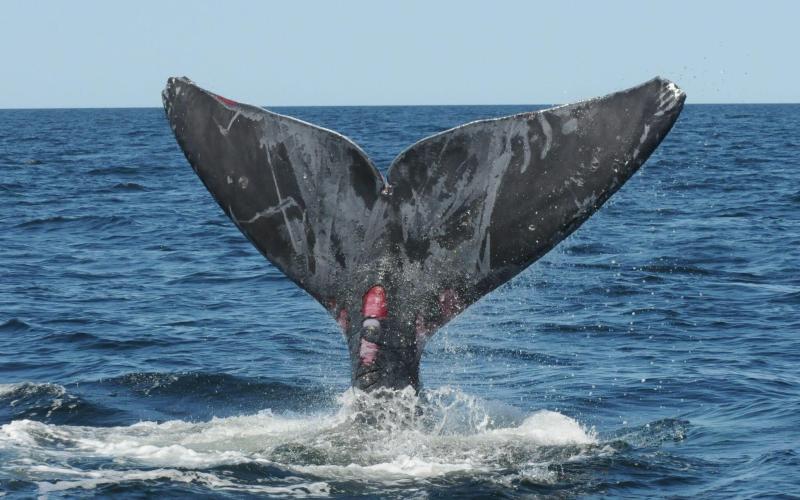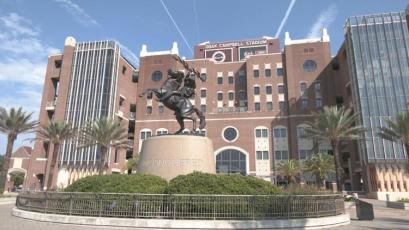The National Oceanic and Atmospheric Administration announced an $82 million investment from the Biden-Harris administration to conserve and recover North Atlantic right whales. The funding comes from a $2.6 billion framework to invest in coastal resilience through the Inflation Reduction Act, making up the largest direct investment into conservation in America’s history.
Every year, pregnant and nursing right whale mothers migrate to the warmer waters of Northeast Florida and the surrounding region. Here, they nurse their calves and spend critical one-on-one time with them. The breeding season begins in mid-November and ends in mid-April. The 2023 Right Whale Festival splashes down in Fernandina Beach the first weekend of November.
North Atlantic right whales are approaching extinction. With less than 350 total and 70 breeding females left, every whale saved is considered a huge success. As population numbers have declined, the number of births every year has also begun to show signs of stagnation. In the 2022 season, 15 calves were born. In the 2023 season, 12 calves were born, though one was found dead from malnourishment soon after being spotted without its mother.
NOAA says that North Atlantic right whales “can probably live for at least 70 years,” and whale species closely related to right whales can live up to 100 years. Female North Atlantic right whales are now only living to around 45 years old and males to around 65 years old. Three years is considered a healthy interval between right whale births. But now, females are having calves every six to 10 years. Right whales have no known natural predators. Between 2003-18, there were 70 North Atlantic right whale deaths recorded between Florida to the Gulf of St. Lawrence, Canada. Not a single juvenile or adult was determined to have died of natural causes, but vessel strikes and fishing gear entanglements.
“During the past decade,” said Janet Coit, assistant administrator for NOAA Fisheries, “right whales have changed their distribution patterns, spending more time in areas with fewer protections from vessel strikes and entanglements. The species has experienced a severe population decline that has underscored the urgency to take new and innovative actions for their recovery.”
Approximately $35.8 million of the grant money will go towards whale activity monitoring and modeling. This includes things like identifying habitats, investigating fatalities, performing population assessments, passive acoustic monitoring and new technology like satellite observation and tracking.
Approximately $20.1 million will go towards vessel strike reduction. NOAA says collisions with boats as small as 30 feet in length can be lethal to right whales, especially calves. Funding will go towards developing vessel strike reduction technology, right whale alert systems and mandatory vessel reporting systems. NOAA Fisheries will convene a North Atlantic Right Whale Vessel Strike Risk Reduction Technology Workshop Feb. 13-15, in Washington, D.C., and virtually.
The International Fund for Animal Welfare explains, “Vessel strikes cause agonizing and deadly injuries, such as open wounds and blunt-force trauma. Fishing gear weighs whales down, stopping them from moving freely, feeding or reproducing. The gear can also cut into their blubber, muscle and even bones and they slowly die of infection, exhaustion or starvation.”
NOAA estimates 85% of all right whales have been entangled in fishing gear at least once. To that end, approximately $17.9 million is supporting the development and use training of on-demand fishing gear, also called ropeless gear.
Traditional methods use a rope that attaches on one end to a cage on the seafloor and a buoy on the other end, and fishermen are able to retrieve gear by pulling up the rope. Large whales can get caught in these ropes so on-demand gear removes them, eliminating the threat of entanglement.
NOAA is working with fishermen and manufacturers to champion three types of on-demand gear systems. Pop-up buoys are released from a cage and uncoil a rope to the surface, lift bags that inflate underwater are attached to cages and lines that can be wrapped around buoyant spools tethered to cages. All three methods rely on signals being sent and received between a boat on the surface and its cages, triggering an action by the gear on the seafloor.
About $5 million of the federal investment into right whales will go toward enforcement. NOAA can modify shipping lanes, implement fishing season closures, regulate the maximum breaking strength for fishing and buoy lines and request voluntary speed reductions. But if fisheries don’t care enough to change their behavior, NOAA now has more funding to go after vessels that don’t comply with regulations.
Approximately $3.2 million will go towards the general support of North Atlantic right whale support, including administration and project coordination and management.
The North Atlantic right whale got its name from the days when whaling was still legal. Whalers called them the “right whale” to kill because they spend much of their time near the surface of the water and they float when dead, making for an easy harvest.
“We applaud this huge investment to help protect our right whales,” said Candis Whitney, Amelia Island Whale Ambassadors. “The excellent initiatives included help the whales, as well as offering many potential solutions to assist fisherman and vessel operators.”
“With less than 350 critically endangered North Atlantic right whales left in our oceans, every life counts,” continued Whitney. “Extinction is forever.”
srosenthal@fbnewsleader.com




